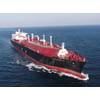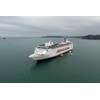Bloom Energy, Samsung to Design Electric Ships
California-based Bloom Energy, the provider of stationary fuel cells, has announced a collaboration with South Korean shipbuilder Samsung Heavy Industries (SHI), to design and develop ships powered by Bloom Energy’s solid oxide fuel cell technology.
SHI aims to be the first shipbuilder to deliver a large cargo ship for ocean operation powered by fuel cells running on natural gas. Such an innovation will play a key role in helping the company exceed the 50 percent emissions reduction target, compared to 2008 levels, that the International Maritime Organization (IMO) has mandated all shipbuilders should achieve by 2050.
The IMO, an arm of the United Nations, is the global standard-setting agency for the safety, security, and environmental performance of international shipping.
The two companies have already taken an important first step towards commercializing the maritime use of fuel cells for propulsion and auxiliary power. At a ceremony in the SHI Geoje shipyard, Samsung Heavy Industries announced they have received Approval in Principle from DNV GL, the internationally accredited marine shipping registrar and classification society, in collaboration with Bloom Energy to proceed with a fuel cell-powered ship design for Aframax crude oil tankers (COTs).
“As regulations to reduce GHG emissions take effect step-by-step, the introduction of fuel cells to vessels is inevitable. This approval, and being the first shipbuilder to secure this marine fuel cell technology, illustrates that Samsung Heavy is highly likely to lead the market,” said Kyunghee Kim, vice president of SHI Outfitting Engineering Team.
“It is a meaningful GHG emissions reduction measure to apply Bloom Energy’s fuel cell system to SHI’s new Aframax design. SHI’s new Aframax design is equipped with a new generating system in combination of the conventional, generator engines, and the new fuel cell technology, both fueled with LNG,” said Hwa Lyong Lee, vice president of Regional Business Development, Maritime at DNV GL. “This innovative design is one of the ways to improve GHG emissions, to further make LNG a solid and long-term solution.”
Related News





